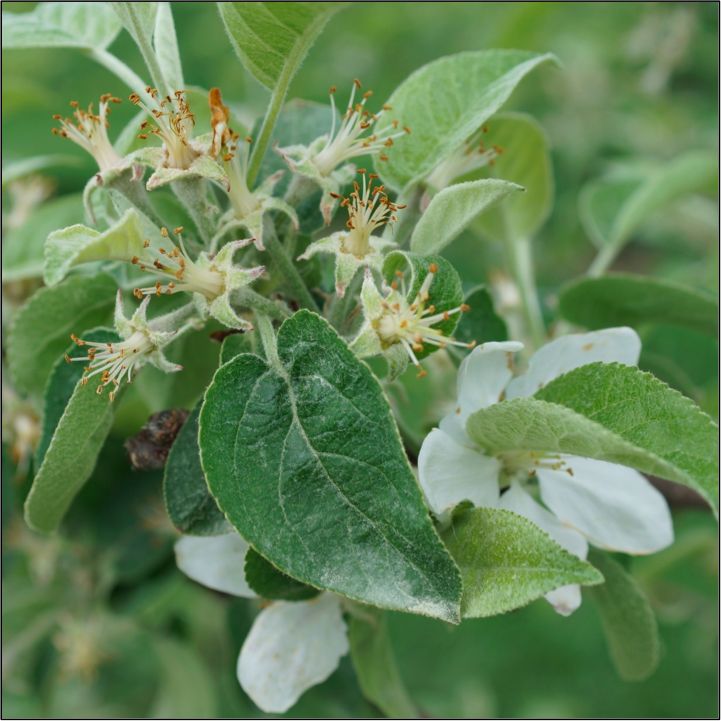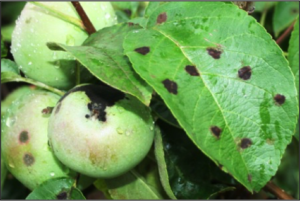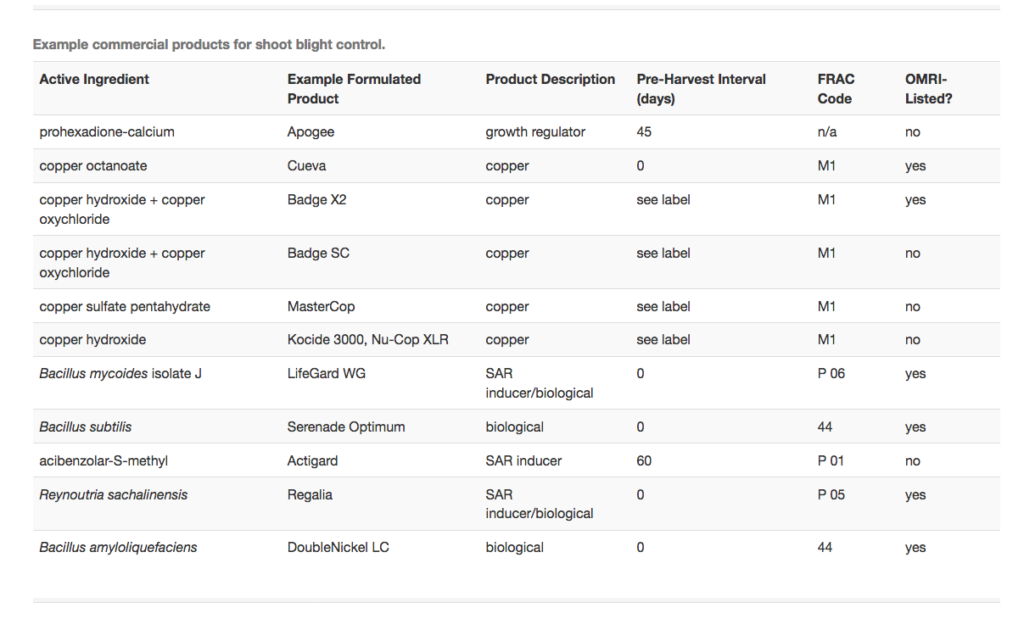Apple Disease Update: Petal Fall
go.ncsu.edu/readext?521688
en Español / em Português
El inglés es el idioma de control de esta página. En la medida en que haya algún conflicto entre la traducción al inglés y la traducción, el inglés prevalece.
Al hacer clic en el enlace de traducción se activa un servicio de traducción gratuito para convertir la página al español. Al igual que con cualquier traducción por Internet, la conversión no es sensible al contexto y puede que no traduzca el texto en su significado original. NC State Extension no garantiza la exactitud del texto traducido. Por favor, tenga en cuenta que algunas aplicaciones y/o servicios pueden no funcionar como se espera cuando se traducen.
Português
Inglês é o idioma de controle desta página. Na medida que haja algum conflito entre o texto original em Inglês e a tradução, o Inglês prevalece.
Ao clicar no link de tradução, um serviço gratuito de tradução será ativado para converter a página para o Português. Como em qualquer tradução pela internet, a conversão não é sensivel ao contexto e pode não ocorrer a tradução para o significado orginal. O serviço de Extensão da Carolina do Norte (NC State Extension) não garante a exatidão do texto traduzido. Por favor, observe que algumas funções ou serviços podem não funcionar como esperado após a tradução.
English
English is the controlling language of this page. To the extent there is any conflict between the English text and the translation, English controls.
Clicking on the translation link activates a free translation service to convert the page to Spanish. As with any Internet translation, the conversion is not context-sensitive and may not translate the text to its original meaning. NC State Extension does not guarantee the accuracy of the translated text. Please note that some applications and/or services may not function as expected when translated.
Collapse ▲The good news this week is that according to infection models, primary scab season is over for all locations in NC with a Gala green tip date of 2/28/19 or earlier. All remaining ascospores were released on April 14th. Continue to scout trees for apple scab symptoms over the next few weeks. If scab lesions are observed, secondary scab will need to be managed. Fortunately several of the fungicides used for Glomerella leaf spot and bitter rot will also control apple scab.
 The late bloom/petal fall application represents one of the more critical timings for powdery mildew management. Protectant fungicides such as the EBDCs (e.g. mancozeb or ziram) or captan have little efficacy against this disease. Trials at MHCREC have demonstrated that under high disease pressure, products containing a FRAC 11 fungicide (“Strobys”) tend to have the greatest efficacy (see chart below). If you do not have S.I. (FRAC 3) resistance, TopGuard and Rally 40WSP also have a high level of activity against apple powdery mildew. SDHI fungicides (Group 7) are considered relatively weak against powdery mildew, particularly under high disease pressure. However, in our trials at MHCREC we still observed a 50 to 70% reduction in mildew incidence when SDHIs were applied from bloom through 2nd cover.
The late bloom/petal fall application represents one of the more critical timings for powdery mildew management. Protectant fungicides such as the EBDCs (e.g. mancozeb or ziram) or captan have little efficacy against this disease. Trials at MHCREC have demonstrated that under high disease pressure, products containing a FRAC 11 fungicide (“Strobys”) tend to have the greatest efficacy (see chart below). If you do not have S.I. (FRAC 3) resistance, TopGuard and Rally 40WSP also have a high level of activity against apple powdery mildew. SDHI fungicides (Group 7) are considered relatively weak against powdery mildew, particularly under high disease pressure. However, in our trials at MHCREC we still observed a 50 to 70% reduction in mildew incidence when SDHIs were applied from bloom through 2nd cover.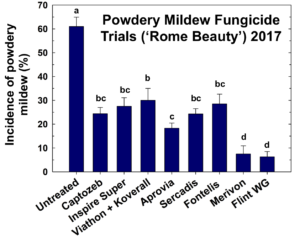
 Management for the shoot blight stage of fire blight should also begin around petal fall. In order for shoot blight to occur, their must be inoculum present within or near an orchard (i.e. there must be a local inoculum source). Thus, even just a few blossom blight infections can serve as a strong catalyst for shoot blight infection. Shoot blight is the result of infection to young, emerging leaf tissue. Injury to this susceptible leaf tissue provides the means for bacteria to invade and progress down young shoots. Insects with sucking or piercing mouth parts, or other types of wounds created from environmental conditions (e.g. hail, wind, soil abrasion, etc). Application of a plant growth regulator, prohexadione calcium (marketed as Apogee or Kudos) has demonstrated the greatest efficacy against shoot blight in commercial plantings and in research trials. The chemical retards shoot growth, thereby reducing the amount of susceptible tissue available. Prohexadione calcium also thickens xylem cell walls acting as a barrier to the bacterium. At least two applications of prohexadione calcium should be applied during the season for shoot blight management. For mature trees a 6-12 oz/100 gal rate is recommended at 1-3″ of shoot growth and then 14-21 days later. For trees less than 5 years old in which you are trying to fill the canopy, make applications at the same timings but at a reduced rate of 3-6 oz/100 gallons. If you are concerned about stunting tree growth, other (often less efficacious) options are below in the figure. For more information on shoot blight refer to the NCSU Fire Blight Fact Sheet.
Management for the shoot blight stage of fire blight should also begin around petal fall. In order for shoot blight to occur, their must be inoculum present within or near an orchard (i.e. there must be a local inoculum source). Thus, even just a few blossom blight infections can serve as a strong catalyst for shoot blight infection. Shoot blight is the result of infection to young, emerging leaf tissue. Injury to this susceptible leaf tissue provides the means for bacteria to invade and progress down young shoots. Insects with sucking or piercing mouth parts, or other types of wounds created from environmental conditions (e.g. hail, wind, soil abrasion, etc). Application of a plant growth regulator, prohexadione calcium (marketed as Apogee or Kudos) has demonstrated the greatest efficacy against shoot blight in commercial plantings and in research trials. The chemical retards shoot growth, thereby reducing the amount of susceptible tissue available. Prohexadione calcium also thickens xylem cell walls acting as a barrier to the bacterium. At least two applications of prohexadione calcium should be applied during the season for shoot blight management. For mature trees a 6-12 oz/100 gal rate is recommended at 1-3″ of shoot growth and then 14-21 days later. For trees less than 5 years old in which you are trying to fill the canopy, make applications at the same timings but at a reduced rate of 3-6 oz/100 gallons. If you are concerned about stunting tree growth, other (often less efficacious) options are below in the figure. For more information on shoot blight refer to the NCSU Fire Blight Fact Sheet.
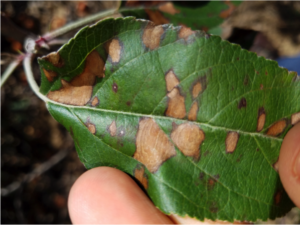 Lastly, applications targeting Glomerella leaf spot and bitter rot should begin at petal fall. Cultivars with ‘Golden Delicious’ parentage such as ‘Gala’, ‘Pink Lady’, and of course ‘Golden Delicious’ are susceptible to Glomerella leaf spot and fruit rot, caused primarily by the fungal pathogen Colletotrichum fructicola in North Carolina. The more common bitter rot of apple, which most often just involves fruit infection, can be found on most apple cultivars in the Southeast. In North Carolina, Colletotrichum fioriniae is most commonly associated with this disease. Symptoms of Glomerella leaf spot begin as small purple flecks which under high disease pressure or in the absence of fungicides rapidly expand into tan/brown irregular lesions often containing concentric rings. As the disease progresses, leaves become chlorotic (yellow) and premature defoliation occurs. In the fruit rot stage of the disease, infections often appear as slightly depressed enlarged lenticels or spots and expand into larger rots as the season progresses. Under warm and humid conditions, fungal structures called acervuli or orange/salmon colored conidia might be present. A more in-depth post focusing on Glomerella leaf spot and fruit rot will be published next week. In that post I will focus on some of the research that’s been ongoing in my program and by my graduate student, Kendall Johnson. For more information please check out the NCSU Glomerella Leaf Spot and Fruit Rot Fact Sheet. In the meantime, here are some recommendations as we approach petal fall and Glomerella Season!
Lastly, applications targeting Glomerella leaf spot and bitter rot should begin at petal fall. Cultivars with ‘Golden Delicious’ parentage such as ‘Gala’, ‘Pink Lady’, and of course ‘Golden Delicious’ are susceptible to Glomerella leaf spot and fruit rot, caused primarily by the fungal pathogen Colletotrichum fructicola in North Carolina. The more common bitter rot of apple, which most often just involves fruit infection, can be found on most apple cultivars in the Southeast. In North Carolina, Colletotrichum fioriniae is most commonly associated with this disease. Symptoms of Glomerella leaf spot begin as small purple flecks which under high disease pressure or in the absence of fungicides rapidly expand into tan/brown irregular lesions often containing concentric rings. As the disease progresses, leaves become chlorotic (yellow) and premature defoliation occurs. In the fruit rot stage of the disease, infections often appear as slightly depressed enlarged lenticels or spots and expand into larger rots as the season progresses. Under warm and humid conditions, fungal structures called acervuli or orange/salmon colored conidia might be present. A more in-depth post focusing on Glomerella leaf spot and fruit rot will be published next week. In that post I will focus on some of the research that’s been ongoing in my program and by my graduate student, Kendall Johnson. For more information please check out the NCSU Glomerella Leaf Spot and Fruit Rot Fact Sheet. In the meantime, here are some recommendations as we approach petal fall and Glomerella Season!
- Fungicide: Flint or Luna Sensation or Merivon + Mancozeb (3 lb/A) at Petal Fall and First Cover; OR Flint or Luna Sensation or Merivon + Mancozeb (3 lb/A) at Petal Fall and 2nd Cover; OR Flint or Luna Sensation or Merivon + Mancozeb (3 lb/A) at 1st Cover and 2nd Cover; OR Flint or Luna Sensation or Merivon + Mancozeb (3 lb/A) at 1st Cover and 3rd Cover. Basically, I’d time your fungicide containing a strobilurin (FRAC 3) prior to a heavy rainfall during the PF-3rd cover period. If not applying a stroby during these sprays, use Fontelis or Aprovia plus Mancozeb; or Captan (1/2 rate) + Mancozeb!
- Tighten up spray intervals between Petal Fall and 3rd Cover: Do not go more than 7 to 10 days without a fungicide application!
- Tighten spray intervals even further if more than 2 inches of rain, high humidity, or hot weather
- Manage weeds to reduce inoculum: Weeds can serve as alternative hosts, plus managing weeds should help to reduce humidity in the lower canopy.
Some final thoughts as we approach petal fall here in NC:
- Be careful applying captan between petal fall and 3rd cover. Captan is an excellent fungicide, and when applied alone can do little harm. From Petal through 3rd cover, however, tank mixtures are complex: insecticides, surfactants, thinners, nutrient applications, etc. Research I conducted with Dr. Kerik Cox at Cornell showed that the incidence and severity of phytotoxicity was enhanced when particular brands of captan were used or when they were applied with some surfactants. That report can be found in the Spring 2015 edition of the New York Fruit Quarterly.
- Cedar apple rust can still be a problem at this time of year. If you’ve had problems in the past, consider including an S.I. (FRAC 3) fungicide in your tank mixture.
- Mancozeb is highly effective at controlling Glomerella leaf spot and fruit rot. Consider tailoring your applications to maximize its use and also staying within the 77 day PHI limit. For example, even though mancozeb needs to be discontinued on early harvest cultivars such as ‘Gala’, consider continuing its application on ‘Pink Lady’ for a bit longer due to its October harvest date.



